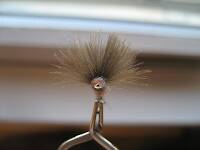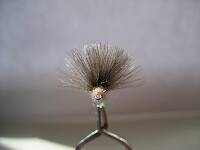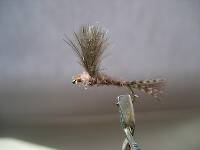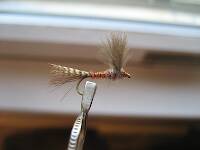
Blue-winged Olives
Baetis
Tiny Baetis mayflies are perhaps the most commonly encountered and imitated by anglers on all American trout streams due to their great abundance, widespread distribution, and trout-friendly emergence habits.
Featured on the forum

Nymphs of this species were fairly common in late-winter kick net samples from the upper Yakima River. Although I could not find a key to species of Zapada nymphs, a revision of the Nemouridae family by Baumann (1975) includes the following helpful sentence: "2 cervical gills on each side of midline, 1 arising inside and 1 outside of lateral cervical sclerites, usually single and elongate, sometimes constricted but with 3 or 4 branches arising beyond gill base in Zapada cinctipes." This specimen clearly has the branches and is within the range of that species.

Troutnut is a project started in 2003 by salmonid ecologist Jason "Troutnut" Neuswanger to help anglers and
fly tyers unabashedly embrace the entomological side of the sport. Learn more about Troutnut or
support the project for an enhanced experience here.
BrettB on Jan 28, 2008January 28th, 2008, 12:10 am EST
I had a small epiphany this weekend driving home from the Somerset, NJ Fly Fishing Show. It seems to me that there are actually two types of fly tying wax: More paraffin-based wax that essentially coats and smoothes thread and keeps its fibers together. In skiing terminology I'd call it "glide" wax. Then, there is the really tacky stuff (kick wax), of which Overton's "Wonder Wax" is still the best I ever found. It seems to have more glue, liquidity and stickyness (and a lower melting point?) than the harder wax so common now. Lay a piece of Overton's wax-coated thread on a pile of loose dubbing and you'll pick up half the pile. Lay a piece of paraffin-based "waxed" thread on that same pile and you'll just pull up a few fibers here and there. Those of us who grew up dubbing with Overton's miss that super-tacky feel and usefulness.
After chatting with Paul Ptalis at the show it seems that the Overtons Wonder Wax has been out of production a decade or more, yet he's still using the same stick he bought in the early 80's.
Does anyone have a clue about what made Overton's so tacky and what a suitable ingredient other than beeswax and paraffin might be for a good tacky "kick" wax for fly tying? Maybe with his extensive ski knowledge, GONZO will have some insight. All thoughts welcome.
After chatting with Paul Ptalis at the show it seems that the Overtons Wonder Wax has been out of production a decade or more, yet he's still using the same stick he bought in the early 80's.
Does anyone have a clue about what made Overton's so tacky and what a suitable ingredient other than beeswax and paraffin might be for a good tacky "kick" wax for fly tying? Maybe with his extensive ski knowledge, GONZO will have some insight. All thoughts welcome.
Brett Billings
long-time tyer and amateur entomologist
long-time tyer and amateur entomologist
JAD on Jan 28, 2008January 28th, 2008, 12:34 am EST
what a suitable ingredient other than beeswax and paraffin might be for a good tacky "kick" wax for fly tying? Maybe with his extensive ski knowledge, GONZO will have some insight. All thoughts welcome.
Well first time poster. Welcome Brett. I'm not Gonzo (better looking) Try a toilet ring sealing gasket some rosin . you will have to try different amounts of rosin till you get right amount.(for you),I then put mine in Chap Stick containers.
I been using mine for last 20 years.
Regards
JaD
Well first time poster. Welcome Brett. I'm not Gonzo (better looking) Try a toilet ring sealing gasket some rosin . you will have to try different amounts of rosin till you get right amount.(for you),I then put mine in Chap Stick containers.
I been using mine for last 20 years.
Regards
JaD
They fasten red (crimson red) wool around a hook, and fix onto the wool two feathers which grow under a cock’s wattles, and which in colour are like wax.
Radcliffe's Fishing from the Earliest Times,
Softhackle on Jan 28, 2008January 28th, 2008, 3:35 am EST
Hi,
Preference and application has a lot to do with tying wax. Some tiers use no wax at all, while others like the tacky stuff. There are many different kinds of wax available. I prefer something of beeswax rather than paraffin. Straight beeswax is great for waxing thread that is curling or unruly. Just carefully run the thread through a piece. For general dubbing, I use Rainbow wax, which is no longer available. I have a tube that I continue to use from many years ago. This is perhaps why it's no longer being sold. It lasted too long. I have full tube I haven't even touched yet, so I'm set for a while
My son recently got some wax by Wapsi, and for general dubbing, I think the consistency is good.
For special applications of feathers and fur I like Loon Tacky Wax.
Whatever you prefer, use it frugally. You don't want to "gum up the works" so to speak.
Here's an interesting page. Copy and paste into your browser:
http://globalflyfisher.com/tiebetter/dubbingwax/
Mark
Preference and application has a lot to do with tying wax. Some tiers use no wax at all, while others like the tacky stuff. There are many different kinds of wax available. I prefer something of beeswax rather than paraffin. Straight beeswax is great for waxing thread that is curling or unruly. Just carefully run the thread through a piece. For general dubbing, I use Rainbow wax, which is no longer available. I have a tube that I continue to use from many years ago. This is perhaps why it's no longer being sold. It lasted too long. I have full tube I haven't even touched yet, so I'm set for a while
My son recently got some wax by Wapsi, and for general dubbing, I think the consistency is good.
For special applications of feathers and fur I like Loon Tacky Wax.
Whatever you prefer, use it frugally. You don't want to "gum up the works" so to speak.
Here's an interesting page. Copy and paste into your browser:
http://globalflyfisher.com/tiebetter/dubbingwax/
Mark
"I have the highest respect for the skilled wet-fly fisherman, as he has mastered an art of very great difficulty." Edward R. Hewitt
Flymphs, Soft-hackles and Spiders: http://www.troutnut.com/libstudio/FS&S/index.html
Flymphs, Soft-hackles and Spiders: http://www.troutnut.com/libstudio/FS&S/index.html
CaseyP on Jan 28, 2008January 28th, 2008, 8:56 am EST
Mark, could you check your link to Global Flyfishers? for a couple of days there's been a very odd error message coming up no matter how i try to access the site, and it would be really helpful to know if it's just me or if anyone else has the same difficulty. thanks!
apologies if this is a hijack, but couldn't pass up the opportunity.
apologies if this is a hijack, but couldn't pass up the opportunity.
"You can observe a lot by watching." Yogi Berra
Flybyknight on Jan 28, 2008January 28th, 2008, 9:04 am EST
About 10 years ago a very good friend of mine who happens to run a fly shop in Nicholson, PA bemoaned the fact that Overton's wax was no longer available. It seems that Mr. Overton went through a very nasty divorce, chucked the business and went out west and faded into trout bum Nirvana.
Well my friend Ron ties a wicked fly. He likes Overton's because it does not leave his fingers sticky, but it was tacky enough to place a fierce dubbing, meaning that it held on the thread and did not mat down.
Well Ron gave me a small dab and asked me to see what it was made of.
We did an IR analysis, took the results to our own government data base and came up with a petroleum wax that is no longer available.
The tackifier was if I remember correctly was a hydrogenated terpene.
I made up a bunch of samples substituting various aliphatic waxes, and adding the correct grade and amount of rosin, but could not duplicate Overton's performance.
The wax in question had a relatively low melting point. I finally made up a witches brew of wax softened with fish oil, plus the above tack.
Close, but no cigar.
Dick
Well my friend Ron ties a wicked fly. He likes Overton's because it does not leave his fingers sticky, but it was tacky enough to place a fierce dubbing, meaning that it held on the thread and did not mat down.
Well Ron gave me a small dab and asked me to see what it was made of.
We did an IR analysis, took the results to our own government data base and came up with a petroleum wax that is no longer available.
The tackifier was if I remember correctly was a hydrogenated terpene.
I made up a bunch of samples substituting various aliphatic waxes, and adding the correct grade and amount of rosin, but could not duplicate Overton's performance.
The wax in question had a relatively low melting point. I finally made up a witches brew of wax softened with fish oil, plus the above tack.
Close, but no cigar.
Dick
Lightly on the dimpling eddy fling;
the hypocritic fly's unruffled wing.
Thomas Scott
the hypocritic fly's unruffled wing.
Thomas Scott
Dano on Jan 28, 2008January 28th, 2008, 11:36 am EST
It seems that Mr. Overton went through a very nasty divorce, chucked the business and went out west and faded into trout bum heaven.
Wonder how far "west" he went? The address on my Overton's is a PO Box in Libby, Montana. 'Course it doesn't list the ingrediants so this thread caught my attention as mine is about half gone and I figure I'll be out in 15 years or so.....
Dano
Wonder how far "west" he went? The address on my Overton's is a PO Box in Libby, Montana. 'Course it doesn't list the ingrediants so this thread caught my attention as mine is about half gone and I figure I'll be out in 15 years or so.....
Dano
Wbranch on Jan 31, 2008January 31st, 2008, 12:16 pm EST
I seldom use wax except when I'm applying fur to the thread for the LaFontaine Emergent Pupa. When I want to make a "noodle" of dubbing I just apply a bit of mositure to my thumb and index finger and roll the fur onto the thread.
The wax I have is made by Gehrke and it comes in a chapstick style tube except with a diameter of about 7/8".
Here is the link; Scroll down about a half a page and you'll see it for $5.95 a tube.
http://www.linesend.com/product/tying_essentials.shtml
The wax I have is made by Gehrke and it comes in a chapstick style tube except with a diameter of about 7/8".
Here is the link; Scroll down about a half a page and you'll see it for $5.95 a tube.
http://www.linesend.com/product/tying_essentials.shtml
Catskill fly fisher for fifty-five years.
BrettB on Feb 1, 2008February 1st, 2008, 3:20 am EST
Dear advanced class,
Many thanks for the leads and thoughts on waxes and their applications.
1. FlybyKnight - I'm amazed that you've done such in-depth analysis of the Overton's. However, I'm a bit depresseed to hear those ingredients may no longer be available (aliphatic waxes? Which ones, if I may ask?) I wasn't aware that rosin came in various grades. What grade is good for such use? I'm thinking of trying to replicate the overton's (in a simplified way) myself. Where would you get the rosin and aliphatic waxes? Any online sources you can think of for discontinued aliphatic waxes of the sort you mention?
2. I'm aware that not everyone uses waxes - Dave Whitlock does great dubbing with no waxes, though he makes up for that with a half-dozen other chemicals he uses on a hair bass bug. Must be the chemical engineer coming out of him. I'm primarily looking for the super-tackiest wax to use on major stonefly nymphs which I like to look pretty shaggy.
3. JAD - I'll head to Lowe's and see if I can find the gasket and some rosin. Thanks for the hint. Any suggestions on how to melt the stuff together and approx amounts of each to start with? I'm a wax-making rookie.
4. Softhackle - interesting note about the Rainbow Wax - this was part of Overton's issue too, possibly. Paul Ptalis is still using a bottle of Overton's that's more than 15 years old. Plenty left, too. I'll look into Loon Tacky wax. Thanks!
Thank all of you for "waxing eloquent" with those insights, observations and links! Let me know if you think of more on waxes!
Many thanks for the leads and thoughts on waxes and their applications.
1. FlybyKnight - I'm amazed that you've done such in-depth analysis of the Overton's. However, I'm a bit depresseed to hear those ingredients may no longer be available (aliphatic waxes? Which ones, if I may ask?) I wasn't aware that rosin came in various grades. What grade is good for such use? I'm thinking of trying to replicate the overton's (in a simplified way) myself. Where would you get the rosin and aliphatic waxes? Any online sources you can think of for discontinued aliphatic waxes of the sort you mention?
2. I'm aware that not everyone uses waxes - Dave Whitlock does great dubbing with no waxes, though he makes up for that with a half-dozen other chemicals he uses on a hair bass bug. Must be the chemical engineer coming out of him. I'm primarily looking for the super-tackiest wax to use on major stonefly nymphs which I like to look pretty shaggy.
3. JAD - I'll head to Lowe's and see if I can find the gasket and some rosin. Thanks for the hint. Any suggestions on how to melt the stuff together and approx amounts of each to start with? I'm a wax-making rookie.
4. Softhackle - interesting note about the Rainbow Wax - this was part of Overton's issue too, possibly. Paul Ptalis is still using a bottle of Overton's that's more than 15 years old. Plenty left, too. I'll look into Loon Tacky wax. Thanks!
Thank all of you for "waxing eloquent" with those insights, observations and links! Let me know if you think of more on waxes!
Brett Billings
long-time tyer and amateur entomologist
long-time tyer and amateur entomologist
Wbranch on Feb 1, 2008February 1st, 2008, 7:13 am EST
You wrote - "which I like to look pretty shaggy."
If you want to create nymphs with shaggy bodies there is a way much faster and far more effective than using lots of wax.
Get a dubbing twister, form a dubbing loop, apply some rough fur into the loop, spin the twister, and then wrap the shaggy dubbing noodle.
Here is one that I use.

If you want to create nymphs with shaggy bodies there is a way much faster and far more effective than using lots of wax.
Get a dubbing twister, form a dubbing loop, apply some rough fur into the loop, spin the twister, and then wrap the shaggy dubbing noodle.
Here is one that I use.

Catskill fly fisher for fifty-five years.
Andyg on Feb 4, 2008February 4th, 2008, 5:18 am EST
Flybynight: I have a tube of Overton's Wonder Wax which is all dried up and hard. Your post caught my eye because you mention ingredients like hydrogenated terpene. Any idea what I might be able to blot on the end, perhaps with a wad of cotton, to make it sticky again?
Flybyknight on Feb 4, 2008February 4th, 2008, 10:12 am EST
Andy,
Mineral oil, or toluene,
but it will take a very long time to dissolve,
because the ingredients are combined hot
in manufacture.
Dick
Mineral oil, or toluene,
but it will take a very long time to dissolve,
because the ingredients are combined hot
in manufacture.
Dick
Lightly on the dimpling eddy fling;
the hypocritic fly's unruffled wing.
Thomas Scott
the hypocritic fly's unruffled wing.
Thomas Scott
Andyg on Feb 4, 2008February 4th, 2008, 12:57 pm EST
Flybyknight: Thanks for the suggestion; I'll give both a try. Maybe I can at least make it better than it is now.
BrettB on Feb 8, 2008February 8th, 2008, 4:15 am EST
Wax-making quest continues...
I got the toilet-gasket ring at Lowe's for $1.49 and am visiting a local high-end music shop for the amber-colored rosin ($7). According to instructions at Global Flyfisher's site:
http://globalflyfisher.com/tiebetter/dubbingwax/toilet_ring_wax.html
It should be about 2 parts rosin to 1 part wax (though they suggest refined beeswax, not the toilet sealing gasket.)
Instructions on the site mention to melt the stuff in an old pot or a soda can cut in half. I may try that.
For extra tackiness, if rosin doesn't seem to add enough, then, maybe some sticky beeswax or toluene, though I have no idea where one gets toluene. (Come to think of it, I remember toluene is a pretty carcinogenic substance. Probably not something to deal with in the kitchen.)
Will post next week after I make my first batch of my Overton's replacement wax. (According to post's elsewhere on the WEB, Glenn Overton was thinking about re-releasing his wax as recently as 2002, but it never appeared.)
I searched the US Patent office database, and they have no listing for him and his wax. I note the green bottle says "Patent pending," but it's possible a patent was never registered. The mystery continues.
I got the toilet-gasket ring at Lowe's for $1.49 and am visiting a local high-end music shop for the amber-colored rosin ($7). According to instructions at Global Flyfisher's site:
http://globalflyfisher.com/tiebetter/dubbingwax/toilet_ring_wax.html
It should be about 2 parts rosin to 1 part wax (though they suggest refined beeswax, not the toilet sealing gasket.)
Instructions on the site mention to melt the stuff in an old pot or a soda can cut in half. I may try that.
For extra tackiness, if rosin doesn't seem to add enough, then, maybe some sticky beeswax or toluene, though I have no idea where one gets toluene. (Come to think of it, I remember toluene is a pretty carcinogenic substance. Probably not something to deal with in the kitchen.)
Will post next week after I make my first batch of my Overton's replacement wax. (According to post's elsewhere on the WEB, Glenn Overton was thinking about re-releasing his wax as recently as 2002, but it never appeared.)
I searched the US Patent office database, and they have no listing for him and his wax. I note the green bottle says "Patent pending," but it's possible a patent was never registered. The mystery continues.
Brett Billings
long-time tyer and amateur entomologist
long-time tyer and amateur entomologist
CaseyP on Feb 8, 2008February 8th, 2008, 5:08 am EST
if i'm not mistaken, Toluene is a Big Bad Industrial solvent. a couple of workers died here a while back when they were instructed to use it to clean a big tank--first guy went in, got overcome, and the second went in for him.
that said, it's available as a mixture with xylene in my favorite handy paint-mistake cleaner-upper, Goof Off, and lately Goof Off has packaged itself as a Graffiti Remover, so i'm a big user and fan. no more gang tags in my neighborhood!
it smells terrible, so you're not going to want to cook with it in the house at all. and it's big time flammable. so i hope the first recipe works.
cant' wait to see how you do: i'm tying some nymphs with cat fur, and touch dubbing is the way to go, but my wax is not quite sticky enough to do a really good job.
that said, it's available as a mixture with xylene in my favorite handy paint-mistake cleaner-upper, Goof Off, and lately Goof Off has packaged itself as a Graffiti Remover, so i'm a big user and fan. no more gang tags in my neighborhood!
it smells terrible, so you're not going to want to cook with it in the house at all. and it's big time flammable. so i hope the first recipe works.
cant' wait to see how you do: i'm tying some nymphs with cat fur, and touch dubbing is the way to go, but my wax is not quite sticky enough to do a really good job.
"You can observe a lot by watching." Yogi Berra
Dano on Feb 8, 2008February 8th, 2008, 7:04 am EST
Just a thought....
Anybody try a Post-a-Note in the stick (no pun intended)?
When I first learned how to tie flies (long before Overton's) I didn't use any type of wax, just licked my thumb and index ran it down the thread and applied the dubbing. I think that wax is mainly an aid in controlling the dubbing as you wrap. Spit works just as well....
'Course that's easy for me to say since I still have my original stick of Overton's that I bought back around 1980...FWIW.
Dano
Anybody try a Post-a-Note in the stick (no pun intended)?
When I first learned how to tie flies (long before Overton's) I didn't use any type of wax, just licked my thumb and index ran it down the thread and applied the dubbing. I think that wax is mainly an aid in controlling the dubbing as you wrap. Spit works just as well....
'Course that's easy for me to say since I still have my original stick of Overton's that I bought back around 1980...FWIW.
Dano
Sulphernut on Jun 11, 2008June 11th, 2008, 4:59 am EDT
I too liked the Overton wax...I don't recall what ever happened to the tube I had!! I have since tried a bunch of different waxes,and have only found one that I actually like. ( several of them were actually bad to the point of being completely useless!) What I've been using,is Loon's "SWAX"...the "tacky" formula. This stuff is STICKY!!! If not careful,it can "wad up" on the thread...To avoid this,I swipe the wax down the length of thread I intend to dub on,then wipe it smooth with my thumb and forefinger. You have to keep a rag handy to keep the thumb and forefinger from becoming "bench velcro". This is all a ton of extra work,but if you want to do touch dubbing effectively,you gotta do what you gotta do!!!
Sulphernut
Sulphernut
TricoPsycho on Jun 11, 2008June 11th, 2008, 6:23 am EDT
Is Overton's intended to be a 'run the stick down the thread' or a 'thumb and forefinger' dubbing wax ? Or is it both ? Just curious, as I've had a tube of Overton's laying around for years which I've never used (I found it in a bag of materials given to me).
Trtklr on Jun 11, 2008June 11th, 2008, 9:13 am EDT
wow all this discussion about wax. what the. . .is going on. I hardly ever use wax. I finally figured out how to use my dubbing wax. I don't put it on my thread, I put it on my fingers when they are too dry.
I have seen nothing more beautiful than the sunrise on a cold stream.
Leakywaders on Jul 4, 2008July 4th, 2008, 2:42 pm EDT
Hi,
In ADVANCED FLY TYING AK Best says to put the wax on your fingers, not the thread, I have followed his advise, and get better results. I have a tin of RUMPF extra tacky wax that I've had for years. No idea where I got it. Fly tying club I belong to teaches beginners with tilet ring wax. One ring is a life time supply for about 20 tyers.
If you want a really sticky "wax" go to Staples, and get a glue stick.
Pete
Ugly, Old man with a white mustash, and a dirty hat
In ADVANCED FLY TYING AK Best says to put the wax on your fingers, not the thread, I have followed his advise, and get better results. I have a tin of RUMPF extra tacky wax that I've had for years. No idea where I got it. Fly tying club I belong to teaches beginners with tilet ring wax. One ring is a life time supply for about 20 tyers.
If you want a really sticky "wax" go to Staples, and get a glue stick.
Pete
Ugly, Old man with a white mustash, and a dirty hat
Drag free??? If the fly didn't drag, I wouldn't know where it was!!
Dr_BlueDun on Jan 29, 2009January 29th, 2009, 1:44 am EST
If you go to Staples look for the paste container (round) that tellers like to use for counting the bucks. This is similar to a finger use paste that Orvis sold several years back. It's an excellent additive to the thread and doesn't leave little nuggets on the thread, plus it wipes off easily--you just need to touch your fingers to it and apply to the thread.
"Doc"
Quick Reply
Related Discussions
Topic
Replies
Last Reply
18
Feb 19, 2016
by TNEAL
by TNEAL









